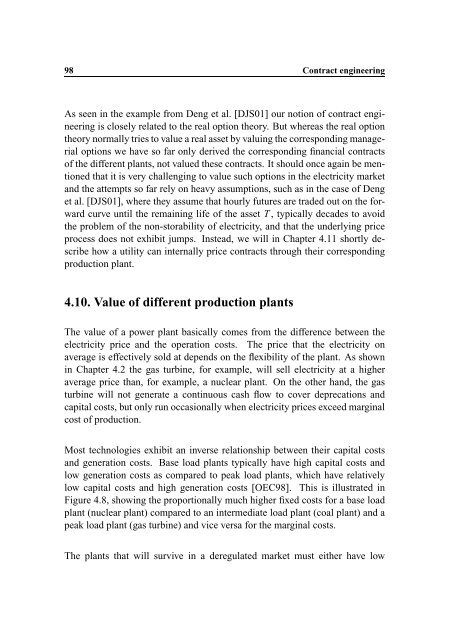Hedging Strategy and Electricity Contract Engineering - IFOR
Hedging Strategy and Electricity Contract Engineering - IFOR
Hedging Strategy and Electricity Contract Engineering - IFOR
You also want an ePaper? Increase the reach of your titles
YUMPU automatically turns print PDFs into web optimized ePapers that Google loves.
98 <strong>Contract</strong> engineering<br />
As seen in the example from Deng et al. [DJS01] our notion of contract engineering<br />
is closely related to the real option theory. But whereas the real option<br />
theory normally tries to value a real asset by valuing the corresponding managerial<br />
options we have so far only derived the corresponding financial contracts<br />
of the different plants, not valued these contracts. It should once again be mentioned<br />
that it is very challenging to value such options in the electricity market<br />
<strong>and</strong> the attempts so far rely on heavy assumptions, such as in the case of Deng<br />
et al. [DJS01], where they assume that hourly futures are traded out on the forward<br />
curve until the remaining life of the asset T , typically decades to avoid<br />
the problem of the non-storability of electricity, <strong>and</strong> that the underlying price<br />
process does not exhibit jumps. Instead, we will in Chapter 4.11 shortly describe<br />
how a utility can internally price contracts through their corresponding<br />
production plant.<br />
4.10. Value of different production plants<br />
The value of a power plant basically comes from the difference between the<br />
electricity price <strong>and</strong> the operation costs. The price that the electricity on<br />
average is effectively sold at depends on the flexibility of the plant. As shown<br />
in Chapter 4.2 the gas turbine, for example, will sell electricity at a higher<br />
average price than, for example, a nuclear plant. On the other h<strong>and</strong>, the gas<br />
turbine will not generate a continuous cash flow to cover deprecations <strong>and</strong><br />
capital costs, but only run occasionally when electricity prices exceed marginal<br />
cost of production.<br />
Most technologies exhibit an inverse relationship between their capital costs<br />
<strong>and</strong> generation costs. Base load plants typically have high capital costs <strong>and</strong><br />
low generation costs as compared to peak load plants, which have relatively<br />
low capital costs <strong>and</strong> high generation costs [OEC98]. This is illustrated in<br />
Figure 4.8, showing the proportionally much higher fixed costs for a base load<br />
plant (nuclear plant) compared to an intermediate load plant (coal plant) <strong>and</strong> a<br />
peak load plant (gas turbine) <strong>and</strong> vice versa for the marginal costs.<br />
The plants that will survive in a deregulated market must either have low
















